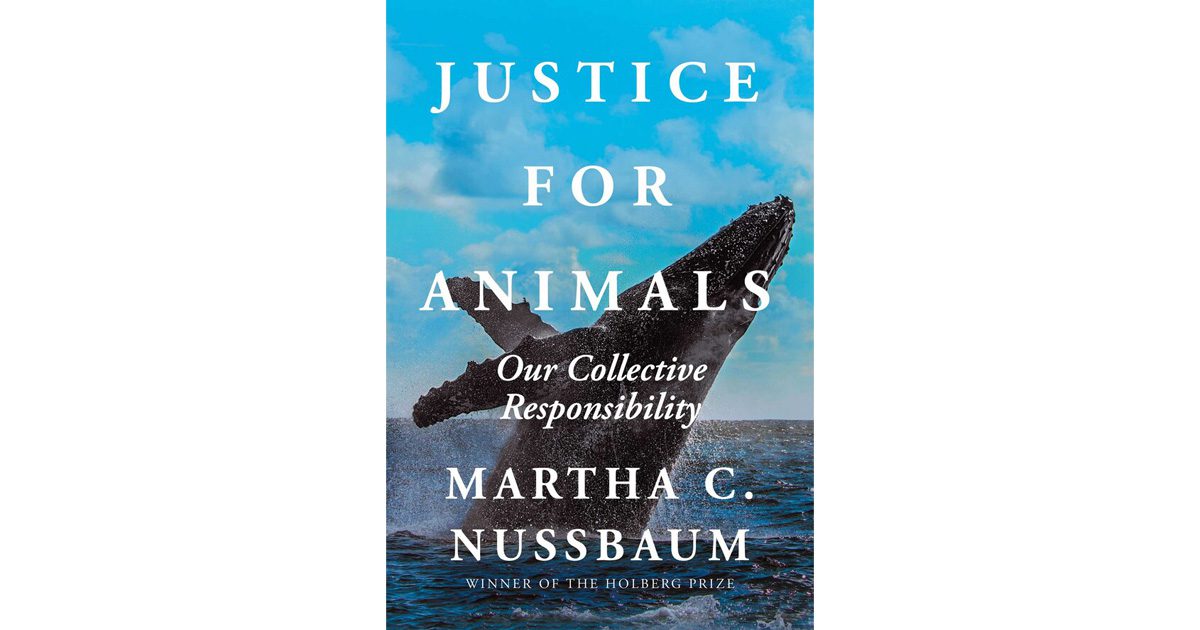
Mar 16, 2023 Justice for Animals: Our Collective Responsibility – By Martha C Nussbaum
Book Review
More has been written on the moral status of animals in the past fifty years than in the previous 5,000. Peter Singer championed the cause of animals using Utilitarian approaches, Tom Regan developed a deontological argument on behalf of animal rights, and Bernard Rollin presented an argument on behalf of an expanded consideration of animal interests based on the Aristotelean concept of an animal’s telos, basically meaning the animal’s purpose. For all three, animal suffering and its avoidance are crucial aspects. Instead, Nussbaum focuses on respect for agency and applies the Capabilities Approach she and Amartya Sen developed to analyze what humans owe to animals.
When applied to humans, the Capabilities Approach asks, “What are people actually able to do and to be?” It is focused on opportunities rather than resources, such as individual incomes at the micro-level or per capita GDP at the macro level. The main features of the Capabilities Approach include treating humans as an end rather than a means (we must respect human dignity), a focus on choice, opportunity, and freedom rather than achievements, treating different capabilities as incommensurable (i.e., one cannot add the value for each capability into a single number), a deep concern with entrenched social injustice and inequality, and to provide clear tasks to government agencies in developing appropriate public policies. Nussbaum identifies ten basic capabilities (opportunities and freedoms) that include, very briefly, life, bodily health, bodily integrity, senses, imagination and thought, emotions, practical reason, affiliation, other species, play, and control over one’s environment. These entitlements impose duties on governments to ensure all citizens meet minimal thresholds for all ten capabilities.
The Capabilities Approach has led to re-evaluating quality-of-life assessments in human development policies. Nussbaum now argues applying the Approach to our treatment of and interactions with animals.
Nussbaum’s book explores several specific issues, such as the relationship between “sentience” and “striving” (both aspects of a flourishing life), the harm of death, and various “tragic conflicts” such as the use of animals in medical research. Nussbaum suggests a way out of “tragic dilemmas” where two important values clash, seemingly without an obvious “right” path forward. Nussbaum supports an approach that “thinks ahead” to develop a world free from the tragic dilemma. In animal research, this could mean a world where we have developed alternative research methods that do not involve animals. For example, NIH Director Dr. Francis Collins envisaged the development of such technologies. At a 2016 Senate Budget Hearing, he predicted that drug development would reach a point in ten years where researchers would no longer be required to use laboratory animals.
In the chapter on Tragic Conflicts, Nussbaum considers animal research and meat eating, where new technologies offer a possible way out of this conflict. She also discusses the preservation of specific cultural events involving practices that cause harm to animals and the challenge of providing sufficient space on a single planet for both wild animals and a growing human population.
In her chapter on companion animals, Nussbaum argues that there “need be nothing wrong” with such a symbiotic relationship as long as our animal companions are not viewed as either “pets” or property but “as active dependent citizens with their own lives to live” (page 221). Her chapter on wild animals asks what responsibilities we have toward wild animals. She argues that today, the human “pretense that ‘the wild’ exists is a way of avoiding responsibility.” Instead, humans must first engage in true stewardship of the earth so that wild animals may thrive and flourish in ways that maximize their capabilities. Second, humans must end practices such as poaching that directly violate wild animal life, health, and bodily integrity and should end practices that heedlessly cause animal death and suffering. Third, humans must protect wild animal habitats from the damages caused by climate change and other human-caused environmental disruptions. Fourth, humans must limit the use of scarce habitat resources to leave room for wild animals. Finally, humans should use our knowledge wisely and deliberately to protect wild animal lives. These are not simple nor easily implemented responsibilities. However, Nussbaum concludes that “the Capabilities Approach offers good guidance where Utilitarian approaches do not: the aim should always be that the animal should be protected in its ability to live a full species-characteristic form of life.” (page 236)
Nussbaum’s penultimate chapter reflects how animals might be treated as full subjects of justice, “capable of standing in a court of law (with a suitable surrogate) in their own right.” She acknowledges how far away such a situation might be but suggests that humanity’s evolving consciousness could lead to appropriate solutions.
Nussbaum’s book provides a carefully argued and expansive vision of how humans might develop a more harmonious and equal relationship with many categories of animals. It will undoubtedly become a foundational classic for legal scholars and the growing worldwide community of animal advocates.


